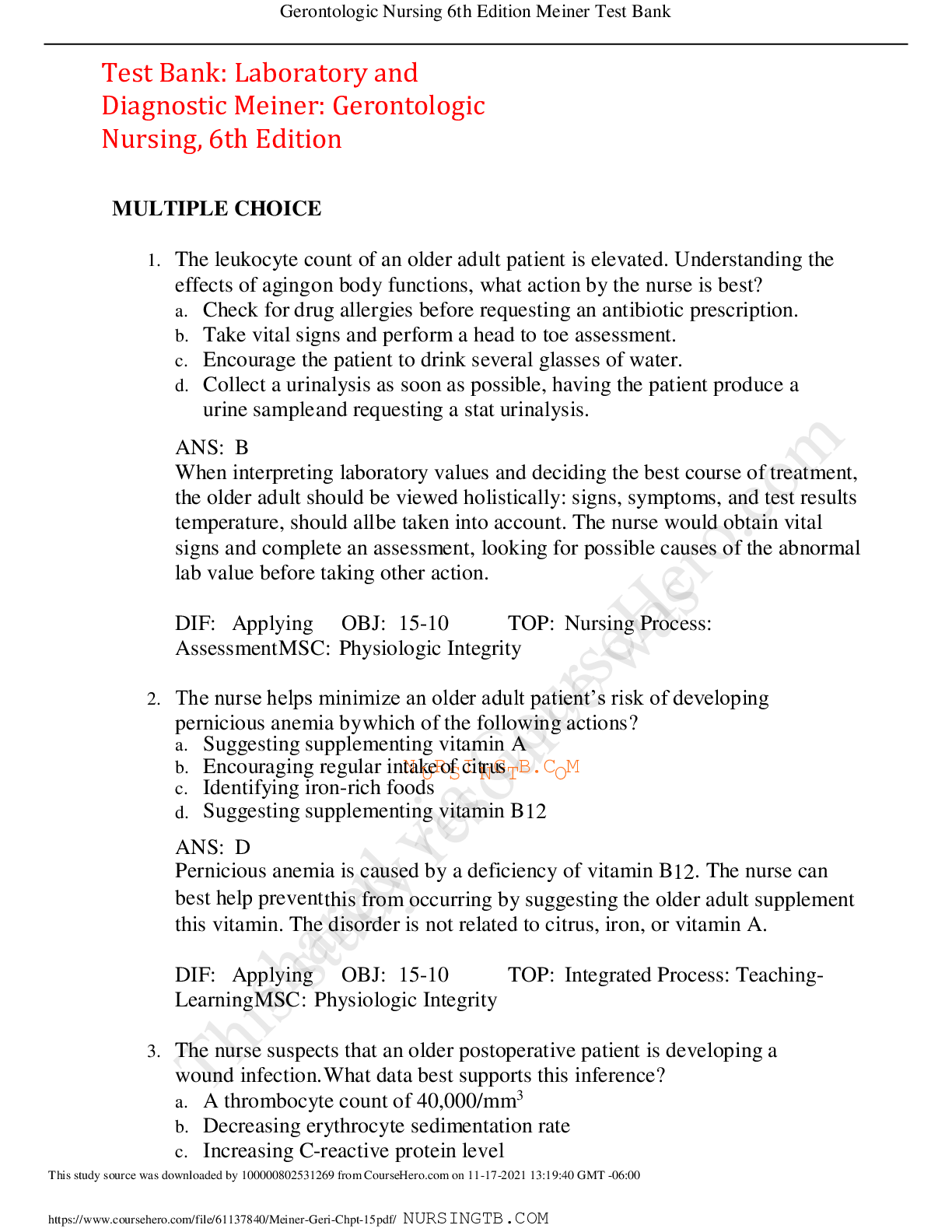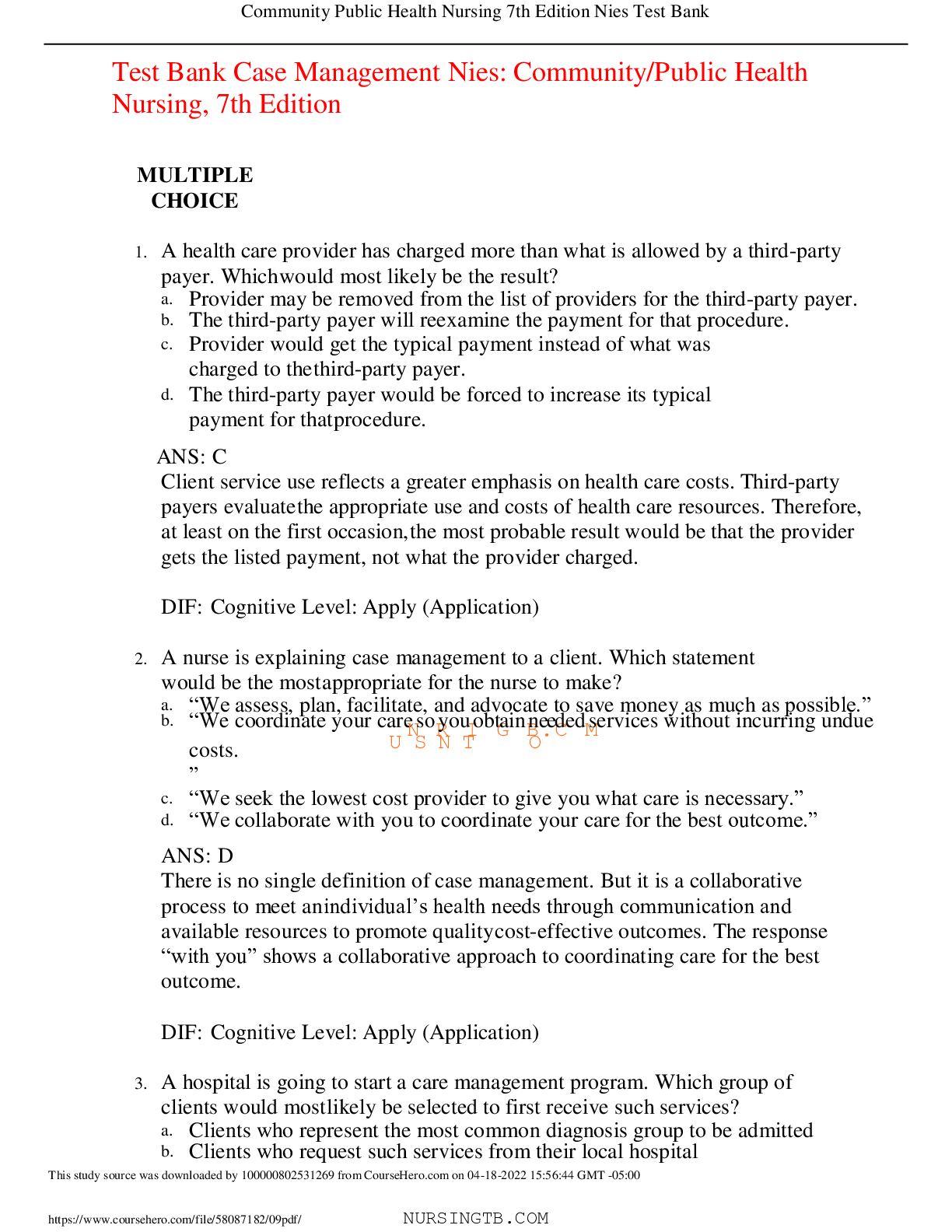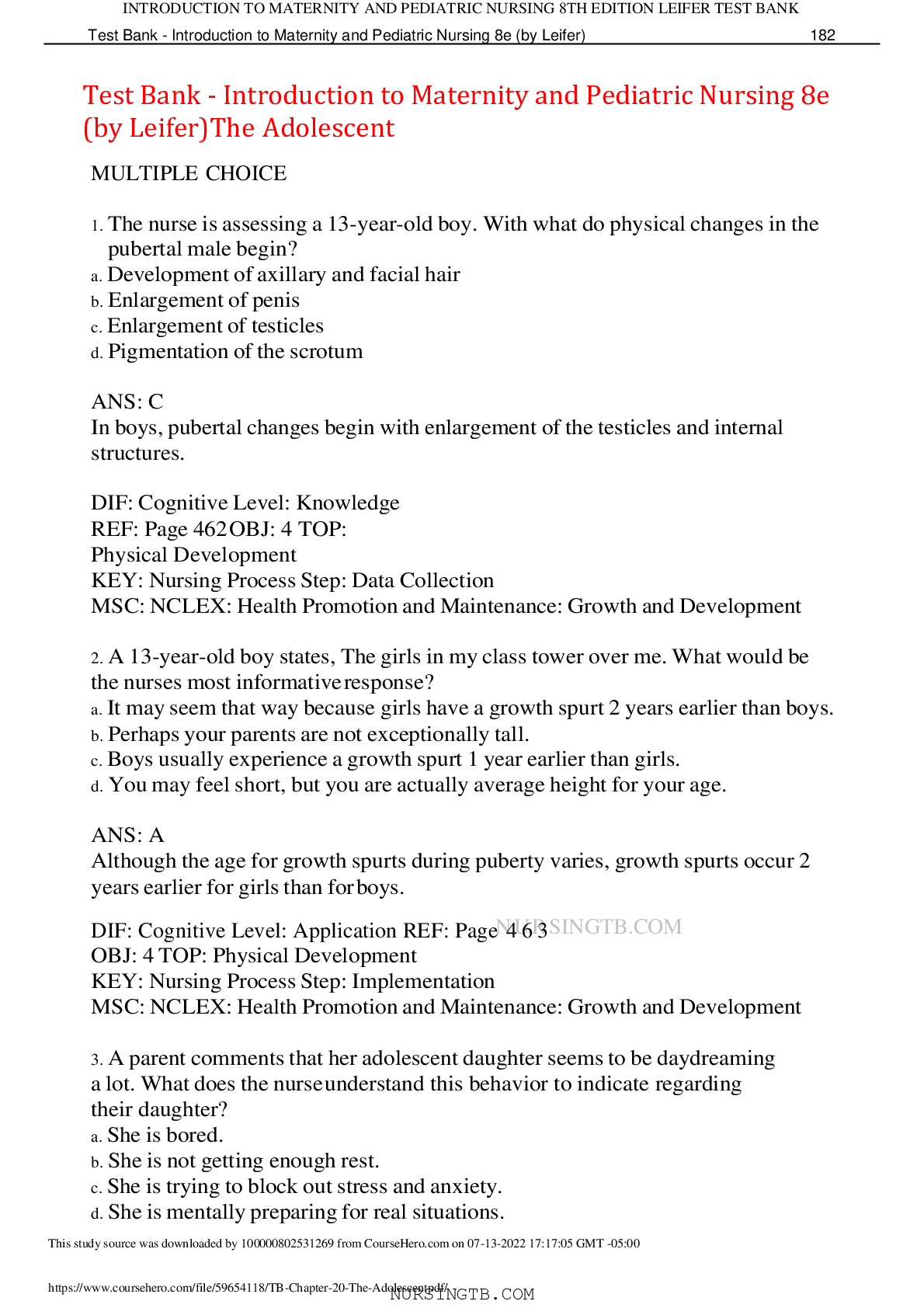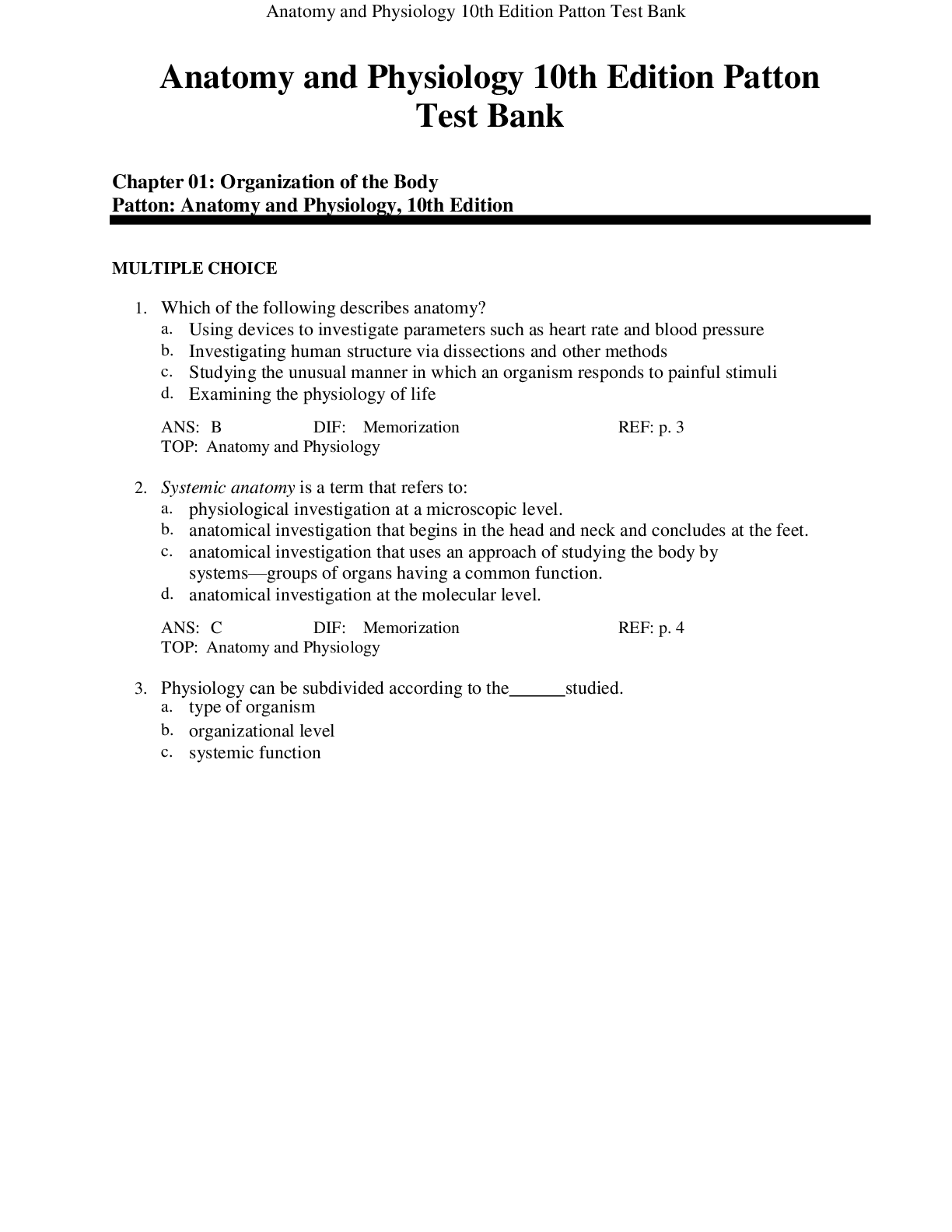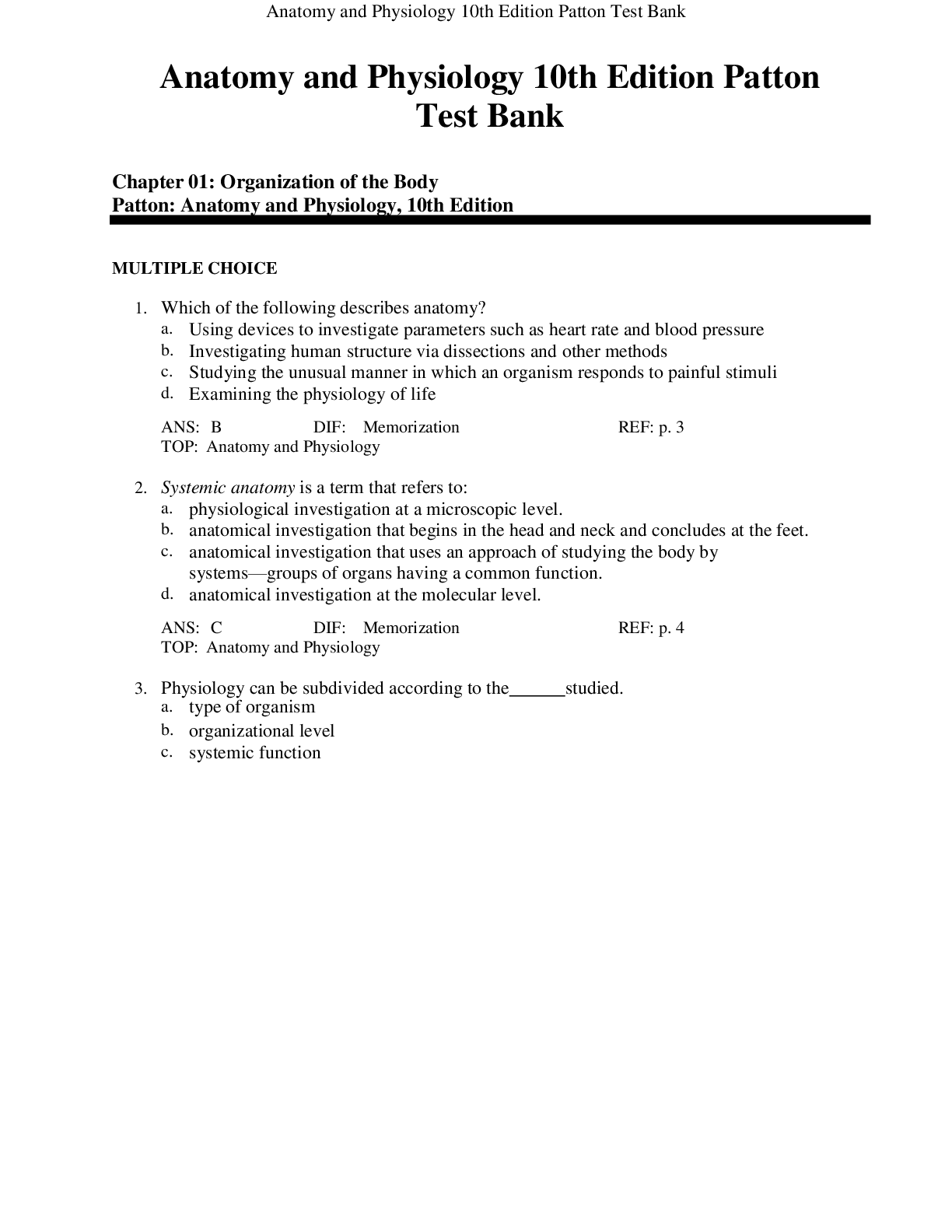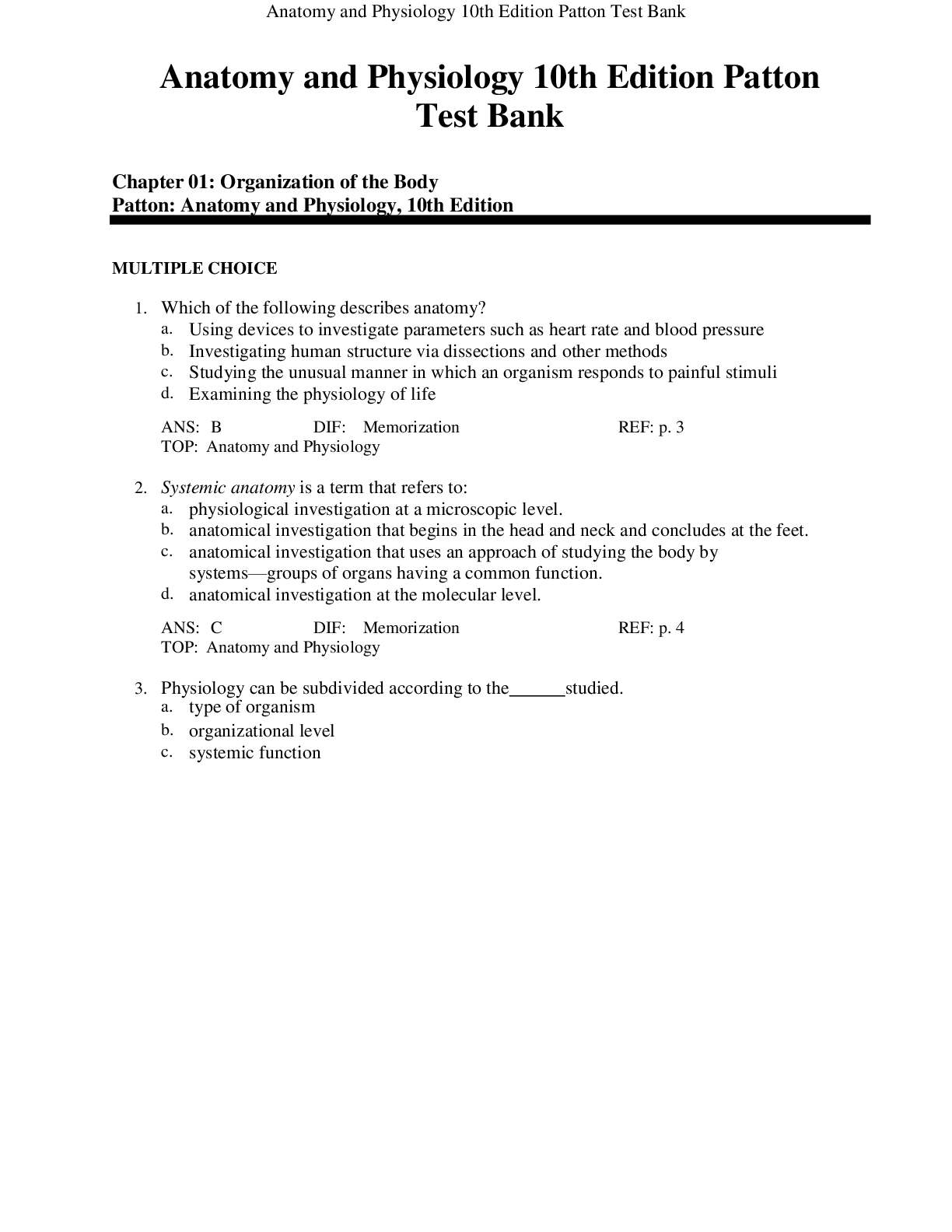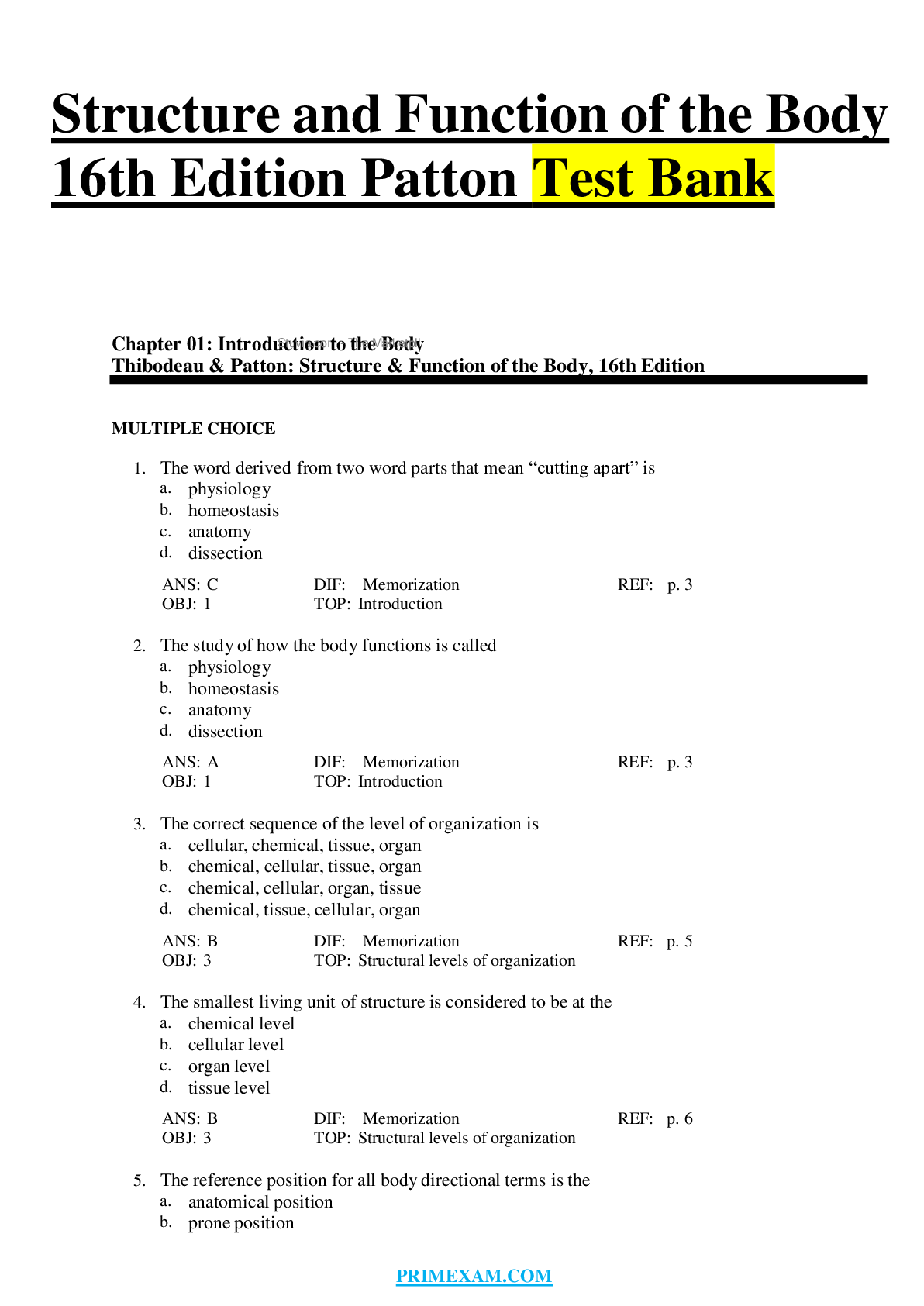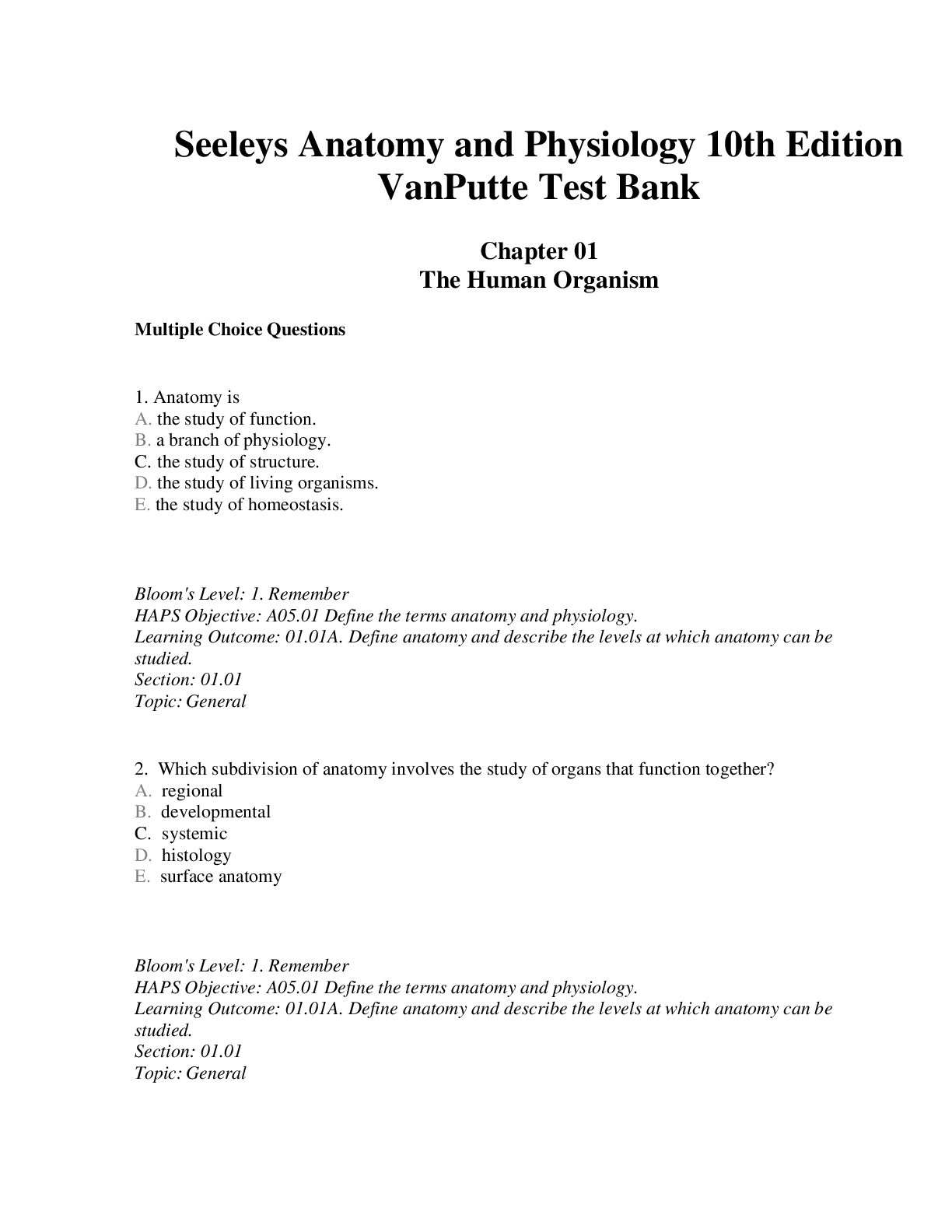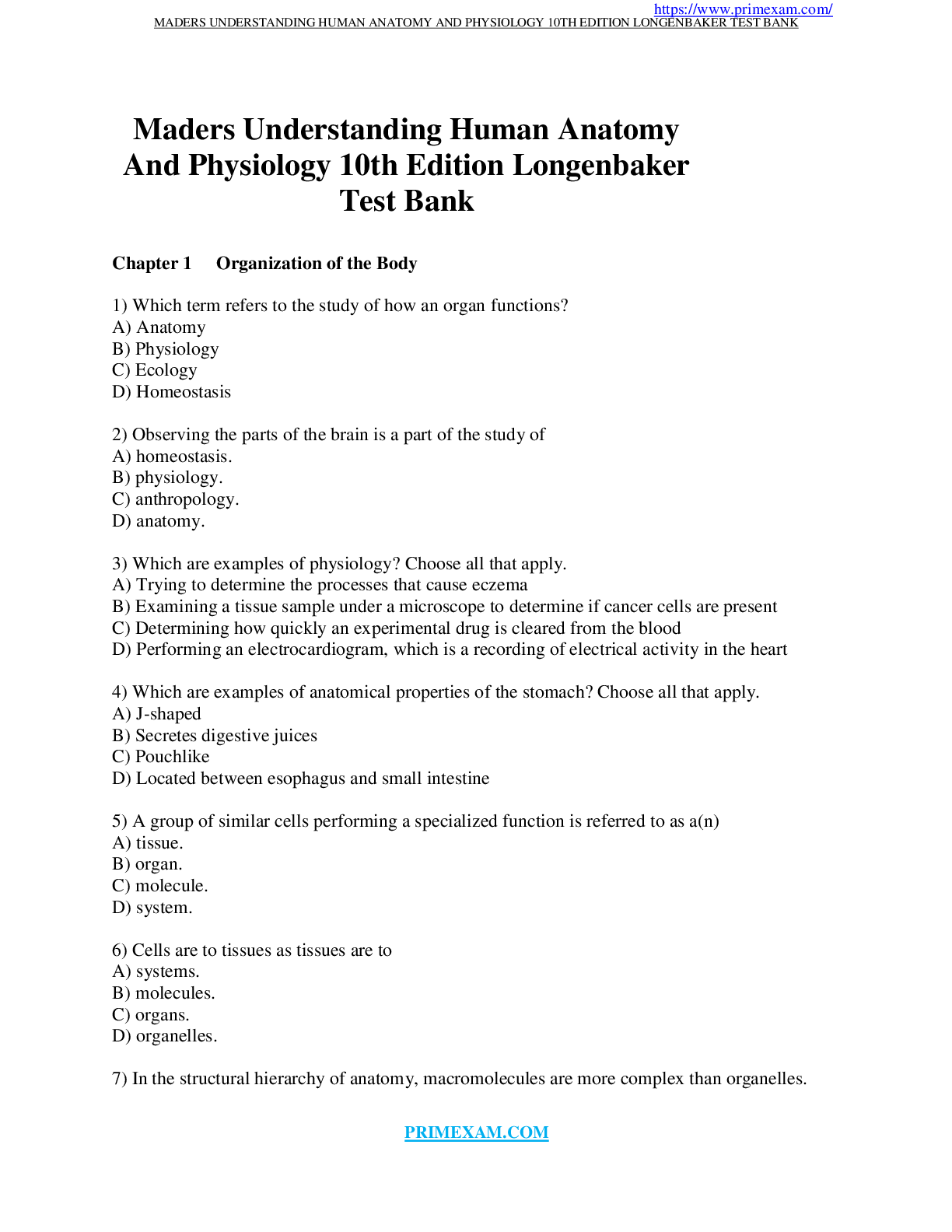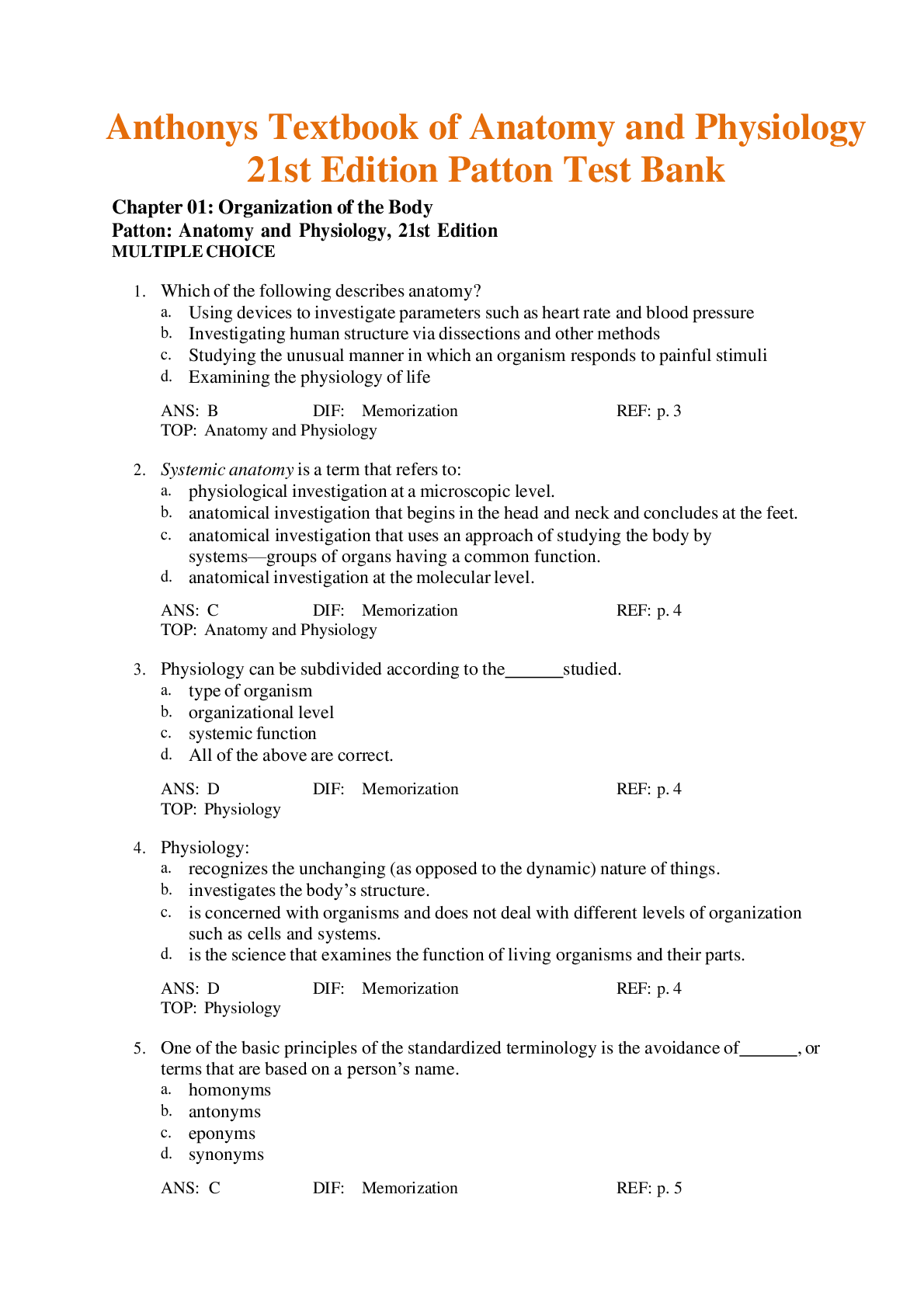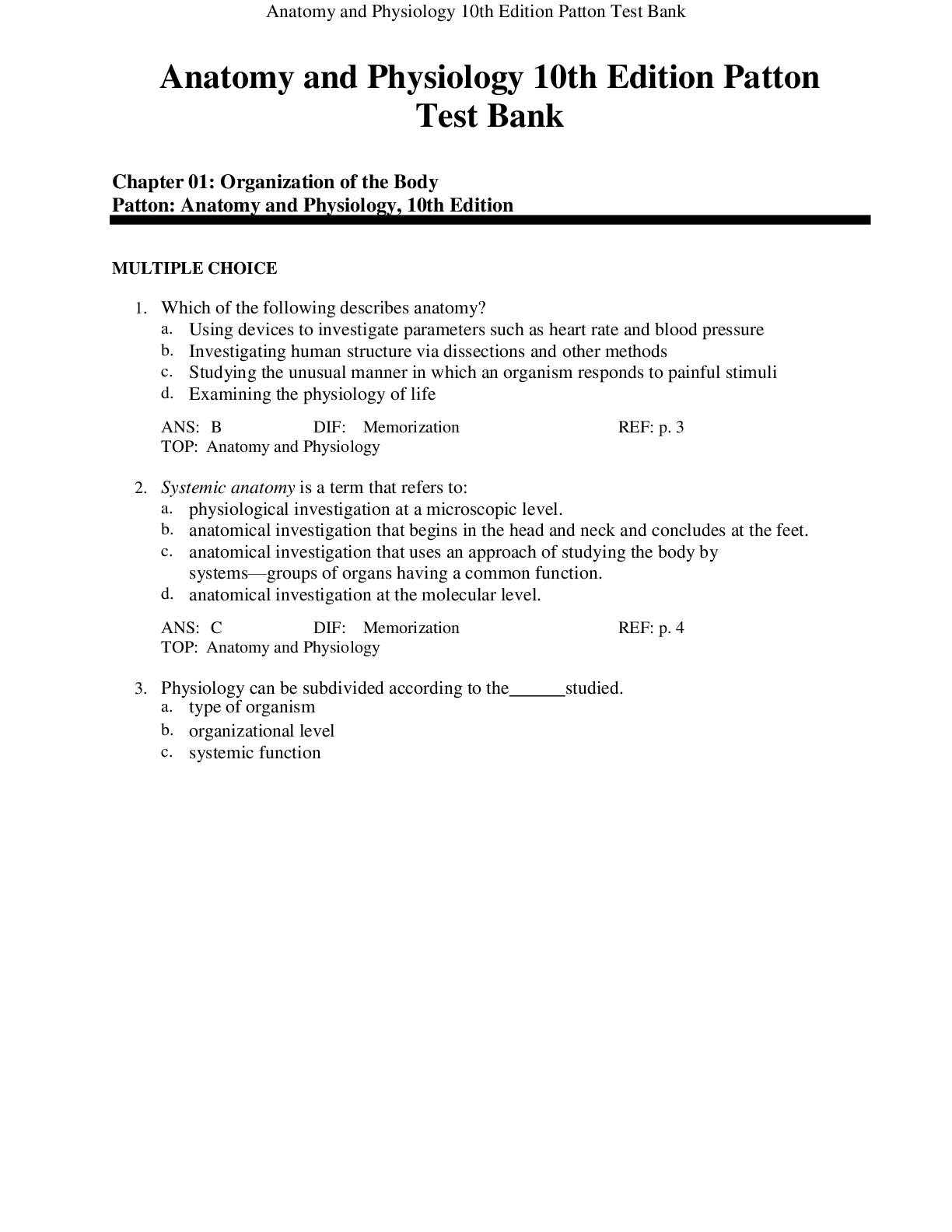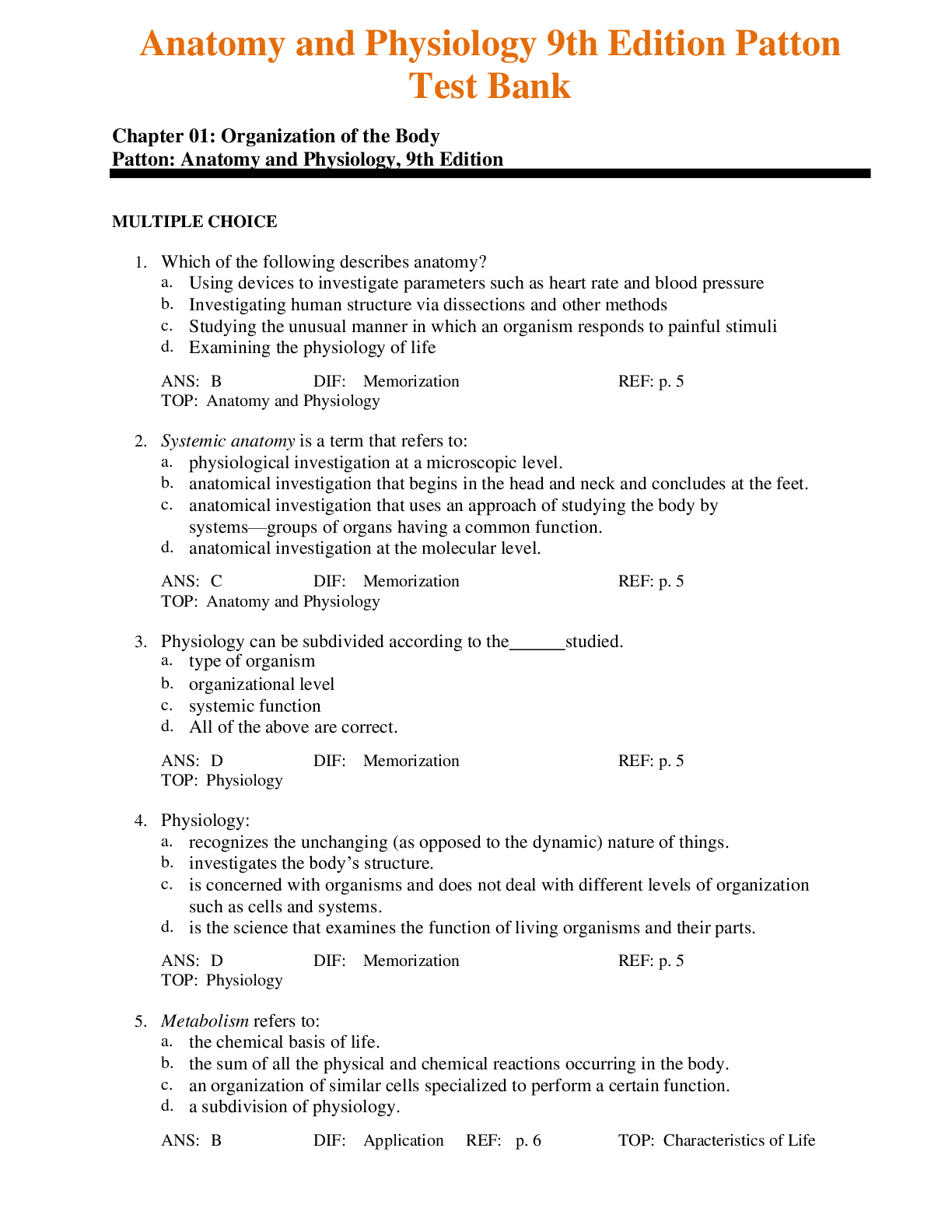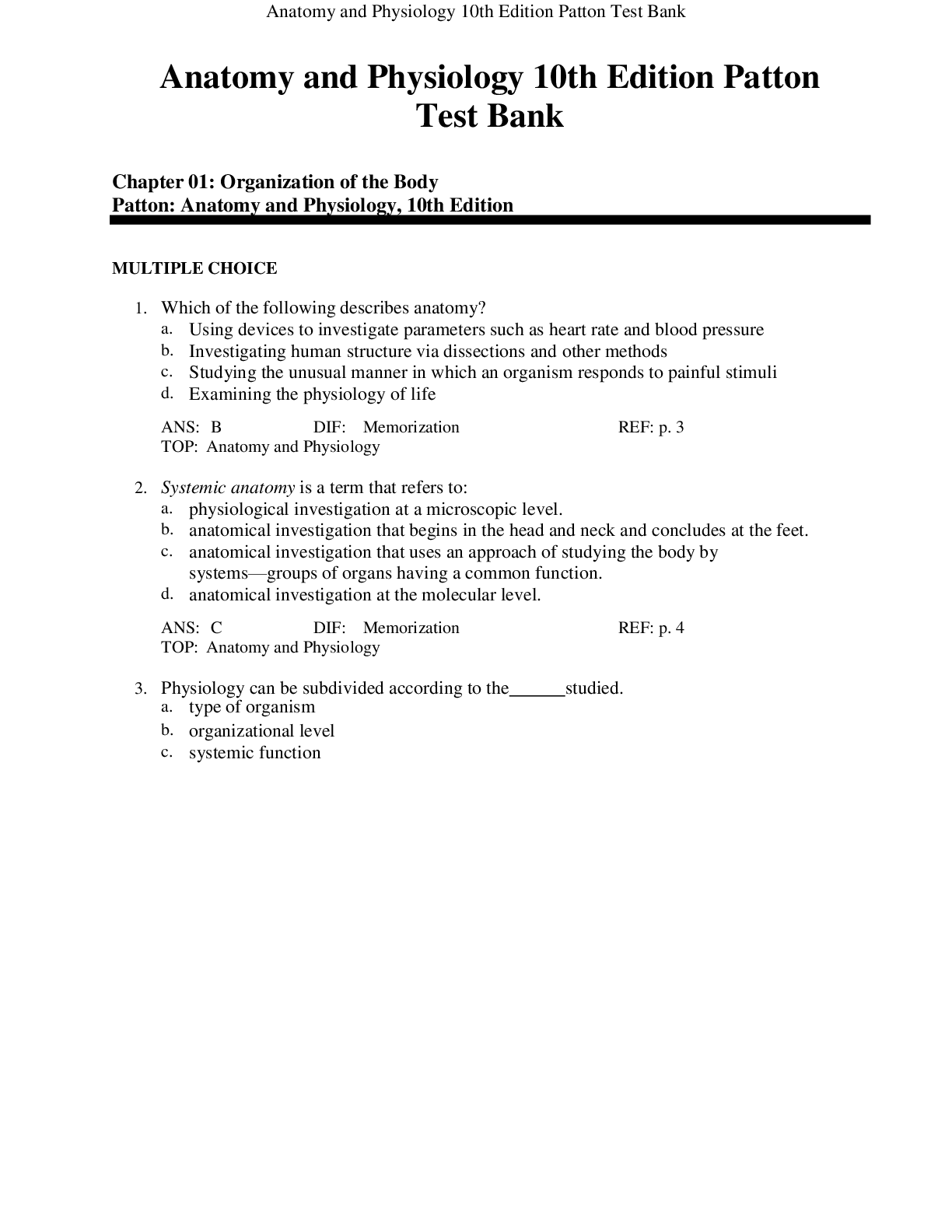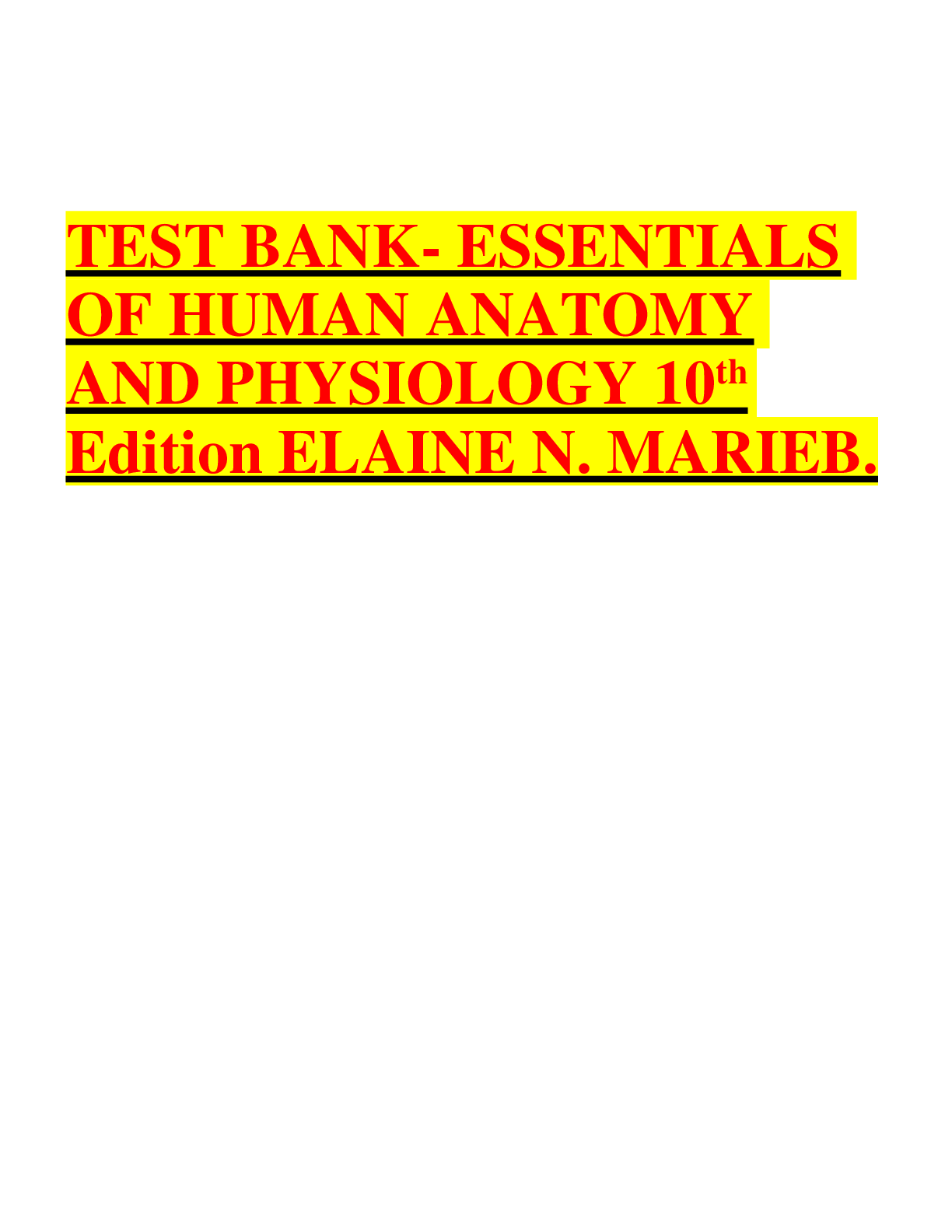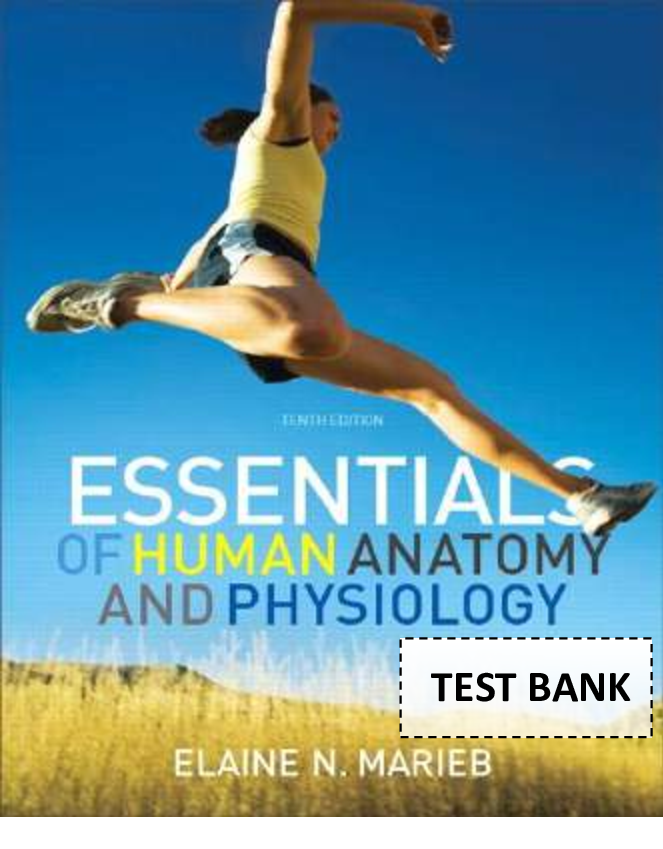*NURSING > TEST BANK > BIOLOGY MISC Biomolecules Patton: Anatomy and Physiology 10th Edition Patton Test Bank,100% CORRECT (All)
BIOLOGY MISC Biomolecules Patton: Anatomy and Physiology 10th Edition Patton Test Bank,100% CORRECT
Document Content and Description Below
BIOLOGY MISC Biomolecules Patton: Anatomy and Physiology 10th Edition Patton Test Bank Chapter 04 MULTIPLE CHOICE 1. Which of the following is not one of the major groups of organic substances ... in the human body? a. Proteins b. Salts c. Lipids d. Nucleic acids ANS: B DIF: Memorization REF: p. 56 TOP: Organic Molecules 2. All of the following substances are organic except: a. lipids. b. electrolytes. c. carbohydrates. d. proteins. ANS: B DIF: Application REF: p. 56 TOP: Organic Molecules 3. The amino group in an amino acid is: a. NH3+. b. COO–. c. symbolized by the letter RN.URSINGTB.COM d. SO2. ANS: A DIF: Memorization REF: p. 63 TOP: Amino Acids 4. Peptide bonds join together molecules of: a. glycerol. b. glucose. c. amino acids. d. water. ANS: C DIF: Application REF: p. 63 TOP: Amino Acids 5. Which lipid is part of vitamin D? a. Glycerol b. Steroids c. Prostaglandins d. Fatty acids ANS: B DIF: Application REF: p. 60 TOP: Steroids 6. The element that is present in all proteins but not in carbohydrates is: a. carbon. b. hydrogen. c. oxygen. d. nitrogen. ANS: D DIF: Synthesis REF: p. 61 TOP: Proteins 7. The formation of sucrose involves the removal of a molecule of water. This is called: a. hydrolysis. b. oxidation. c. decomposition. d. dehydration synthesis. ANS: D DIF: Synthesis REF: p. 57 TOP: Disaccharides and Polysaccharides 8. Humans can synthesize 13 of 21 basic amino acids; the remaining 8, which must be included in the diet, are called: a. enzymes. b. essential amino acids. c. structural proteins. d. peptide bonds. ANS: B DIF: Application REF: p. 63 TOP: Amino Acids 9. The basic building blocks of fats are: a. monosaccharides. b. disaccharides. c. amino acids. d. fatty acids and glycerol. NURSINGTB.COM ANS: D DIF: Memorization REF: p. 58 TOP: Triglycerides or Fats 10. A structural lipid found in the cell membrane is a: a. triglyceride. b. phospholipid. c. steroid. d. Both B and C are correct. ANS: D DIF: Application REF: pp. 59-60 TOP: Phospholipids 11. DNA: a. is a single strand of nucleotides. b. contains the sugar ribose. c. is a double-helix strand of nucleotides. d. transports amino acids during protein synthesis. ANS: C DIF: Application REF: p. 67 TOP: Nucleic Acids and Related Molecules 12. The type of lipoprotein associated with “bad” cholesterol and the production of atherosclerotic changes in blood vessels is: a. HDL. b. LDL. c. VHDL. d. none of the above. ANS: B DIF: Memorization REF: p. 61 TOP: Blood Lipoproteins 13. The types of lipids found that form hormones, such as cortisone, estrogen, and testosterone are: a. triglycerides. b. phosphoglycerides. c. steroids. d. prostaglandins. ANS: C DIF: Application REF: p. 60 TOP: Steroids 14. Which of the following is not one of the three major ingredients of a DNA molecule? a. Sugar b. Nitrogenous bases c. Phosphate d. Lipid ANS: D DIF: Memorization REF: p. 66 TOP: Nucleic Acids and Related Molecules 15. Proteins are composed of commonly occurring amino acids. a. 10 b. 18 c. 21 d. 22 NURSINGTB.COM ANS: C DIF: Memorization REF: p. 63 TOP: Proteins 16. Amino acids frequently become joined by: a. peptide bonds. b. catabolic reactions. c. atrophic reactions. d. all of the above. ANS: A DIF: Application REF: p. 63 TOP: Amino Acids 17. Unsaturated fats: a. contain all the hydrogen atoms they can hold. b. contain only single bonds between carbon atoms. c. are usually solids at room temperature. d. will kink or bend because of the double bonds between the carbon atoms. ANS: D DIF: Application REF: pp. 58-59 TOP: Triglycerides or Fats 18. Which lipid acts as a “tissue hormone”? a. Triglyceride b. Prostaglandin c. Steroid d. Phospholipid ANS: B DIF: Memorization REF: p. 60 TOP: Prostaglandins 19. The alpha helix is an example of which level of protein structure? a. Primary b. Secondary c. Tertiary d. Quaternary ANS: B DIF: Memorization REF: p. 64 TOP: Levels of Protein Structure 20. Which of the following is not true of RNA? a. It contains ribose sugar. b. It contains adenine. c. It is composed of smaller molecules called nucleotides. d. All of the above are true of RNA. ANS: D DIF: Memorization REF: pp. 67-68 TOP: DNA and RNA 21. Which of the following is not a major function of protein? a. Provides structure for the body b. Acts as a catalyst for chemical reactions in the form of enzymes c. Provides energy for the body d. All of the above are funcNtionRs ofIproGteinB. .C M ANS: C DIF: MemUoriSzatioNn T O TOP: Proteins REF: p. 65, Table 4-3 22. Which level of protein structure refers to the number, kind, and sequence of amino acids? a. Primary b. Secondary c. Tertiary d. Quaternary ANS: A DIF: Memorization REF: p. 64 TOP: Levels of Protein Structure 23. Which level of protein structure is one that contains several polypeptide chains? a. Primary b. Secondary c. Tertiary d. Quaternary ANS: D DIF: Memorization REF: p. 64 TOP: Levels of Protein Structure 24. Which of the following is not true of both triglycerides and phospholipids? a. They both contain glycerol. b. They both contain fatty acids. c. They both contain a hydrophobic and hydrophilic end. d. All of the above are true of both triglycerides and phospholipids. ANS: C DIF: Application REF: pp. 58-59 TOP: Triglycerides and Phospholipids 25. Prostaglandins and steroids share which of the following characteristics? a. Both are found in the cell membrane. b. Both have a ring structure in their molecule. c. Both have a saturated fat in their structure. d. None of the above are shared characteristics. ANS: B DIF: Application REF: p. 60 TOP: Steroids and Prostaglandins 26. Which energy-releasing or energy-transferring molecule does not contain a nucleotide? a. FAD b. Creatine phosphate c. NAD d. ATP ANS: B DIF: Memorization REF: p. 68 TOP: Nucleotides and Related Molecules 27. If one side of a DNA molecule is CTAGGCTG, the other side would be: a. CTAGGCTG. b. GATCCGAC. c. CUAGGCUG. d. GAUCCGAC. NURSINGTB.COM ANS: B DIF: Application REF: p. 67 TOP: DNA and RNA 28. The term glycoprotein, a combination of two words, tells you that the compound is made of , with being the dominant component. a. a lipid and a protein; the lipid b. carbohydrate and protein; carbohydrate c. a lipid and a protein; the protein d. carbohydrate and protein; protein ANS: D DIF: Memorization REF: p. 69 TOP: Combined Forms 29. Which of the following is not true of carbohydrates? a. They include substances commonly called sugars. b. They are the body’s primary source of energy. c. They are a part of both DNA and RNA. d. All of the above are true of carbohydrates. ANS: D DIF: Memorization REF: p. 56 TOP: Carbohydrates 30. When two molecules of glucose are joined, they form which disaccharide? a. Sucrose b. Maltose c. Lactose d. Fructose ANS: B DIF: Memorization REF: p. 57 TOP: Carbohydrates 31. A is a functional group that is temporarily unattached and is highly reactive because of unpaired electrons. a. hydroxyl b. phosphate c. amine group d. free radical ANS: D DIF: Memorization REF: p. 56 TOP: Organic Molecules 32. Sometimes referred to as animal starch, is the main polysaccharide in the body. a. sucrose b. maltose c. glucose d. glycogen ANS: D DIF: Memorization REF: p. 57 TOP: Disaccharides and Polysaccharides 33. What is the most important factor in determining the physical and chemical properties of fatty acids? a. Degree of saturation b. Presence of glycerol NURSINGTB.COM c. Available bonds of hydrocarbons d. Polarity ANS: A DIF: Memorization REF: p. 58 TOP: Types of Fatty Acids 34. The roles played by proteins can be divided into which categories? a. Structural and functional b. Chemical and functional c. Structural and chemical d. Dehydration synthesis and hydrolysis ANS: A DIF: Memorization REF: p. 61 TOP: Proteins TRUE/FALSE 1. Proteins are the most abundant of the carbon-containing compounds in the body. ANS: T DIF: Memorization REF: p. 61 TOP: Proteins 2. Glycogen and starch are both examples of polysaccharides. ANS: T DIF: Memorization REF: p. 57 TOP: Disaccharides and Polysaccharides 3. There are a total of 21 essential amino acids. ANS: F DIF: Memorization REF: p. 63 TOP: Amino Acids 4. Steroids are often called tissue hormones. ANS: F DIF: Synthesis REF: p. 60 TOP: Steroids 5. DNA molecules are the largest molecules in the body. ANS: T DIF: Memorization REF: p. 67 TOP: Nucleic Acids 6. Adenine and thymine are referred to as purine bases, which are important constituents of a DNA molecule. ANS: F DIF: Memorization REF: p. 66 TOP: Nucleic Acids 7. The ability of proteins to perform their function depends on their shape or conformation. ANS: T DIF: Application REF: p. 61 TOP: Proteins 8. Enzymes are functional proteNinUsRthSatIbNriGngTmBo.leCcOulMes together or split them apart in chemical reactions. ANS: T DIF: Synthesis REF: p. 61 TOP: Proteins 9. High-density lipoprotein (HDL) is also called the “bad” cholesterol. ANS: F DIF: Application REF: p. 61, Box 4-1 TOP: Blood Lipoproteins 10. The nonessential amino acids cannot be produced from the other amino acids or from simple organic molecules. ANS: F DIF: Memorization REF: p. 63 TOP: Amino Acids 11. Sugars and starches are both considered to be carbohydrates. ANS: T DIF: Memorization REF: p. 56 TOP: Carbohydrates 12. Glucose is a hexose, and ribose is a pentose. ANS: T DIF: Memorization REF: p. 56 TOP: Carbohydrates 13. Nonessential amino acids are rarely used in the making of proteins in the human body. ANS: F DIF: Application REF: p. 63 TOP: Amino Acids 14. Fats, steroids, and prostaglandins are all considered lipids. ANS: T DIF: Memorization REF: p. 58 TOP: Lipids 15. Fats are composed of three fatty acids joined to a molecule of glycerol. ANS: T DIF: Memorization REF: p. 58 TOP: Triglycerides or Fats 16. Saturated fats are more likely than unsaturated fats to be liquid at room temperature. ANS: F DIF: Memorization REF: p. 59 TOP: Triglycerides or Fats 17. Phospholipids have a fat-soluble end and a water-soluble end. ANS: T DIF: Memorization REF: p. 59 TOP: Phospholipids 18. Prostaglandins are associated with the prostate gland and therefore are not found in women. ANS: F DIF: ANppUlicRaStioInNGRTEBF:.Cp.O60M 19. A denatured protein has lost its functional shape. TOP: Prostaglandins ANS: T DIF: Memorization REF: p. 66, Figure 4-16 TOP: Importance of Protein Shape 20. RNA never exists in a double-stranded form. ANS: F DIF: Memorization REF: p. 66, Table 4-4 TOP: DNA and RNA 21. Glycoproteins contain both a fat molecule and a protein molecule. ANS: F DIF: Memorization REF: p. 69 TOP: Combined Forms 22. A sucrose molecule is formed by the synthesis reaction between glucose and fructose. ANS: T DIF: Application REF: p. 57 TOP: Disaccharides and Polysaccharides 23. The quaternary structure of a protein contains more than one polypeptide chain. ANS: T DIF: Application REF: p. 64 TOP: Levels of Protein Structure 24. Both phospholipids and steroids are found in cell membranes. ANS: T DIF: Memorization REF: p. 58 | p. 60 TOP: Phospholipids and Steroids 25. Steroids are the only lipids that contain a ring structure. ANS: F DIF: Memorization REF: pp. 59-60 TOP: Prostaglandins 26. Nucleotides are used to make only RNA or DNA molecules. ANS: F DIF: Memorization REF: p. 67 TOP: Nucleotides and Related Molecules 27. Each helical chain in a DNA molecule has a nitrogen base backbone toward the outside, and phosphate-sugars compose the inner, interlocking base pairs of the interior. ANS: F DIF: Application REF: p. 67 TOP: Nucleic Acids and Related Molecules 28. When ATP is in short supply, muscles can use creatine phosphate for extra energy. ANS: T DIF: Memorization REF: p. 68 TOP: Nucleotides and Related Molecules 29. Both triglycerides and prostaNglanRdinIs caGn coBn.taCin uMnsaturated fat. U S N T O ANS: T DIF: Application REF: p. 59 TOP: Triglycerides and Prostaglandins 30. The three most common disaccharides—sucrose, lactose, and maltose—each contain at least one molecule of glucose. ANS: T DIF: Memorization REF: p. 57 TOP: Disaccharides and Polysaccharides 31. A saturated fat is saturated with hydrogen atoms. ANS: T DIF: Memorization REF: p. 58 TOP: Types of Fatty Acids 32. A triglyceride is composed of a glycerol molecule and three of the same type of fatty acid. ANS: F DIF: Memorization REF: p. 59 TOP: Formation of Triglycerides 33. The body uses the steroid cholesterol to make hormones. ANS: T DIF: Memorization REF: p. 60 TOP: Steroids 34. Proteins can be divided into functional proteins and structural proteins. ANS: T DIF: Memorization REF: p. 61 TOP: Proteins 35. Amino acids get their name because they have an amino group (NH3+) and an acid group (COO–). ANS: T DIF: Memorization REF: p. 63 TOP: Amino Acids 36. When two amino acids are joined, a peptide bond is formed and an H+ ion is released. ANS: F DIF: Memorization REF: p. 63 TOP: Amino Acids 37. The joining of amino acids in a peptide bond is an example of the process of hydrolysis. ANS: T DIF: Memorization REF: p. 63 TOP: Amino Acids 38. Chaperone proteins assist in the proper folding of other proteins so they can have the correct functional shape. ANS: T DIF: Memorization REF: pp. 64-65 TOP: Levels of Protein Structure 39. RNA and DNA have the samNe UpyRrSimIidNinGeTbBas.esCbOutMdifferent purine bases. ANS: F DIF: Memorization REF: p. 67 TOP: DNA and RNA 40. The function of transfer RNA is to select and adhere to a specific amino acid and place it in the correct sequence in the primary protein strand. ANS: T DIF: Memorization REF: p. 67 TOP: DNA and RNA 41. If one side of a DNA molecule is CCTAGGC, the opposite side of the molecule would be CCTAGGC. ANS: F DIF: Memorization REF: p. 66 TOP: DNA and RNA MATCHING Match each term to its corresponding descriptive phrase. a. RNA b. DNA c. Carbohydrate d. Fat e. Steroid f. Protein g. Prostaglandins h. ATP 1. Substance composed of a glycerol molecule and three fatty acid molecules 2. Starch or sugar 3. Lipid found in sex hormone that is made up of four rings 4. Types of lipids that are called tissue hormones 5. Molecule that is the body’s usual source of direct energy 6. Nucleic acid that contains thymine and deoxyribose sugar 7. Substance that is made up of a long chain of amino acids 8. Nucleic acid that contains ribose sugar and uracil 1. ANS: TOP: D DIF: Triglycerides or Fats Memorization REF: p. 58 2. ANS: TOP: C DIF: Carbohydrates Memorization REF: p. 56 3. ANS: TOP: E DIF: Steroids Memorization REF: p. 60 4. ANS: TOP: G DIF: Prostaglandins Memorization REF: p. 60 5. ANS: H DIF: Memorization REF: p. 67 TOP: Nucleotides and Related Molecules 6. ANS: B DIF: Memorization REF: p. 67 TOP: Nucleic Acids and RelatNed MRoleIculeGs B.C M 7. ANS: F DIF: Memorization REF: p. 61 TOP: Proteins 8. ANS: A DIF: Memorization REF: p. 66 TOP: Nucleic Acids and Related Molecules SHORT ANSWER 1. List the types of lipids, and give a function for each type. ANS: Answers will vary. DIF: Application REF: pp. 58-60 TOP: Lipids 2. Explain the different functions performed by RNA in the cell. ANS: Answers will vary. DIF: Memorization REF: pp. 66-67 TOP: DNA and RNA 3. Name and describe the structural levels of protein. ANS: Answers will vary. DIF: Memorization REF: pp. 64-65 TOP: Levels of Protein Structure 4. Compare and contrast the structures of DNA and RNA. ANS: Answers will vary. DIF: Application REF: pp. 66-67 TOP: DNA and RNA ESSAY 1. If one side of a DNA molecule is A-T-C-G-G-T-C-A-G, what would the bases be on the other side of the molecule? On what do you base your answer? ANS: T-A-G-C-C-A-G-T-C DIF: Synthesis REF: p. 66, Table 4-4 TOP: Nucleic Acids 2. Enzymes that are exposed to high heat or low pH solutions lose their ability to function. What causes this to happen? Be specific. ANS: Answers will vary. NURSINGTB.COM DIF: Synthesis REF: p. 66 TOP: Proteins 3. Chaperones are present in every body cell. Discuss the importance of these groups of proteins. ANS: Answers will vary DIF: Application REF: pp. 64-65 TOP: Levels of Protein Structure [Show More]
Last updated: 1 year ago
Preview 1 out of 23 pages
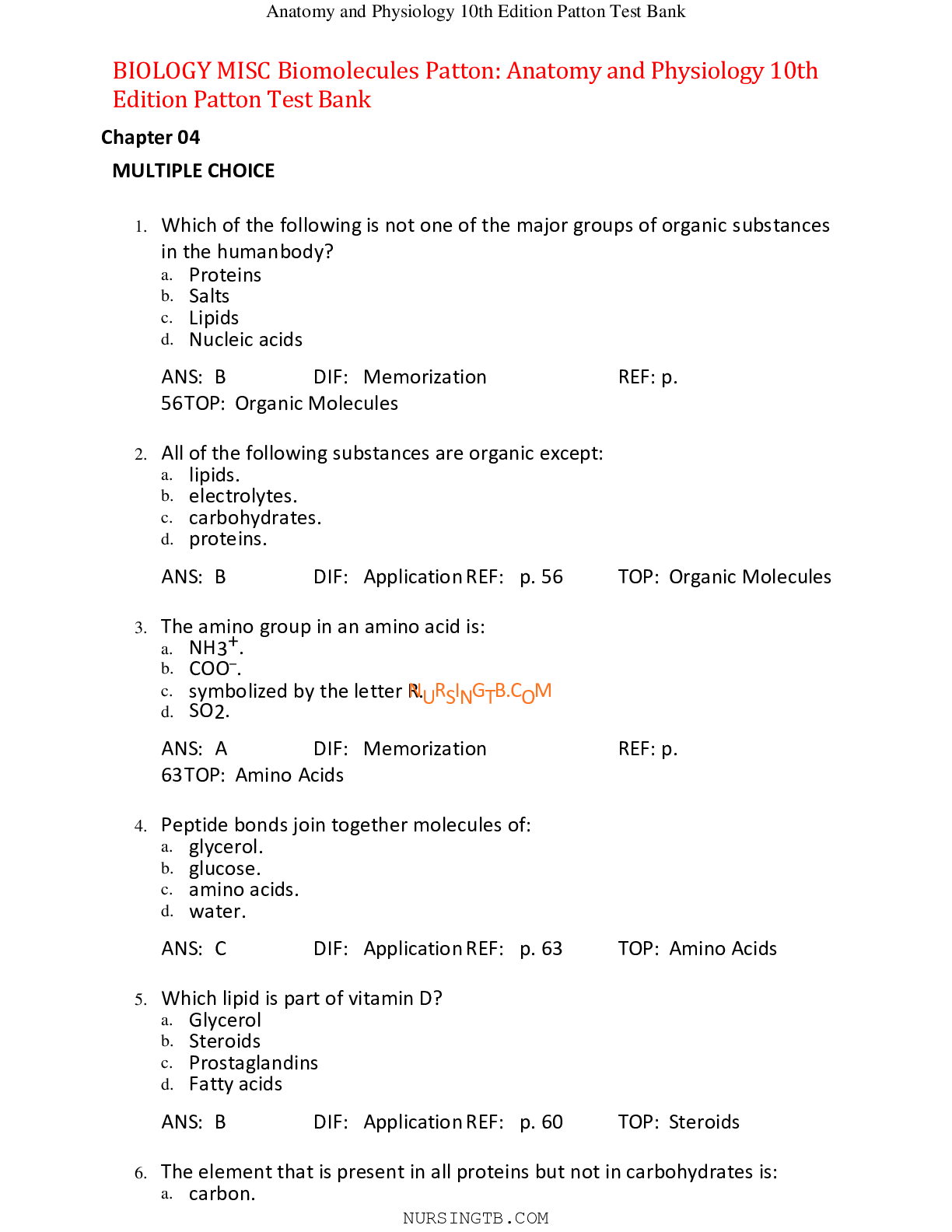
Reviews( 0 )
Document information
Connected school, study & course
About the document
Uploaded On
Nov 23, 2022
Number of pages
23
Written in
Additional information
This document has been written for:
Uploaded
Nov 23, 2022
Downloads
0
Views
25










